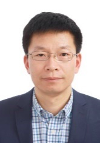2-22.High-throughput Experimental Study of Functional Ceramics Zhifu Liu, Yongxiang Li
Information Functional Materials and Devices Researcher Center, Shanghai Institute of Ceramics, Chinese Academy of Sciences, Shanghai 201899, China
Abstract: Since the 1990s, the high-throughput experimentation (HTE) approach has exerted enormous interest in both academia and industry field for the development of new materials including oxides, metals, and polymers with various forms from the original thin film extended to the liquid, colloid, bulk, powder, etc. Nevertheless, none of the techniques is suitable for preparing dense bulk ceramic libraries. The microstructure of ceramic materials has large effect on their electrical, mechanical, thermal, and other properties. So, it is very important to prepare dense bulk ceramic libraries for the HTE screening of high performance ceramic materials.
We put forward a HTE procedure to synthesize dense bulk ceramic libraries using dry powders as raw materials. The M-Nb-Ti-O (M=Li, Zn) ternary system was investigated as a model material because of the enrich phase composition and high performance microwave dielectric properties. The validity of the HTE ceramic preparation process was confirmed by synthesizing in parallel a group of LiNb0.6Ti0.5O3 ceramics, which showed the same crystalline structures and close dielectric properties. An excellent microwave ceramics with composition of 0.55Li2O-0.05Nb2O5-0.40TiO2 was obtained from the Li-Nb-Ti-O system, which has a dielectric constant of 18.4 and high Qf value of 79000 GHz. A high performance microwave dielectric ceramic with composition of ZnO-Nb2O5-3TiO2, which has a dielectric constant of 78.4 and high Qf value of 13000 GHz, was obtained by the HTE screening in the Zn-Nb-Ti-O material system.
An HTE approaches was also developed to screen the slurry composition for ceramic green tape-casting. The sample libraries were designed considering the variation of the amount of (Poly vinyl-butyral binder, plasticizers, and dispersant. A parallel magnetic stirring process was used to make the combinatorial slurry library. The properties mapping of the slurry libraries was obtained by investigating the sedimentation and rheological characteristics of the slurries. The slurry composition was refined by scaling up the experiments and comparing the microstructure, mechanical property, and sintering behavior of green tapes made from the selected slurries. Finally, a kind of ethanol-ethyl acetate binary solvent based slurry system suitable for making dielectric ceramic green tapes was achieved.
Keywords: Information Functional Ceramics; High-throughput Preparation; Tape-casting Slurry; Multilayered Ceramic Devices
信息功能陶瓷材料的高通量实验研究
刘志甫, 李永祥
中国科学院上海硅酸盐研究所 信息功能材料与器件研究中心
摘要:
一、引言:上世纪九十年代以来,高通量实验技术在材料科学研究领域得到推广应用并推
动了材料科学的发展。较成熟的无机材料高通量制备技术主要是基于软化学方法的粉体制备和基于磁控溅射、脉冲激光沉积等薄膜制备,这些高通量制备技术是工业催化剂、荧光粉、介电 薄膜材料等的高通量评价和筛选的基础。目前,信息功能陶瓷材料使用形态仍以块体或厚膜为 主,材料的微观结构对性能有着重要影响,研究开发块体陶瓷材料以及陶瓷厚膜材料的高通量 制备及表征技术对于实现新型信息功能陶瓷材料的快速发现有重要意义。
二、研究方法:以粉体为原料,通过自动化粉体称量系统进行配料,采用高通量震荡振荡 研磨仪进行混合、多样品组合磨具压片成型、多样品同时烧结,建立起可同时并行制备 16 组以 上样品的陶瓷样品高通量制备方法;建立了陶瓷厚膜流延浆料高通量研究方法;基于中国 科学院的数据云平台,初步建立了功能陶瓷材料的数据库。

图 1 信息功能陶瓷材料与器件高通量实验研究框架示意图
三、主要研究结果:在科技部“863”课题“LTCC 材料高通量设计、制备与表征技术研究”的 资助下,本研究团队近年来在功能陶瓷块体材料、流延浆料高通量制备和筛选方法开发及其在 高性能功能陶瓷材料、陶瓷厚膜以及多层无源元器件研制中的应用取得了系列进展。高通量样 品制备性能一致性实验表明,该高通量并行制备方法得到的样品物相完全吻合,同组分样品间 的介电常数标准差小于 0.2%,频率品质因子(Qf)标准差小于 7%,从而验证了该高通量方法的可 靠性。采用所建立的高通量实验系统和方法开展了微波介质陶瓷材料、无铅压电陶瓷材料的高通量筛选实验研究。较系统的研究了 Li-Nb-Ti-O 和 Zn-Nb-Ti-O 体系中组成、物相结构与 微波介电性能之间的关系,对材料的室温相区进行了重新定义,发现 Zn0.15Nb0.3Ti0.55O2 相具有优良的微波介电性能;究了 xBNT-yBT-zKNN 体系(x>0.85)的组成和性能关系, 发现两个大应变组成区域。采用高通量方法开发出基于乙醇-乙酸乙酯溶剂体系的新型 环境友好流延浆料体系,该流延浆料体系应用于多种功能陶瓷材料,得到系列高质量的 陶瓷厚膜生带,并开发出几类典型无源元器件。
四、小结与展望:初步建立起了信息功能陶瓷材料与器件高通量实验方法并成功用 于功能陶瓷材料与流延浆料的高效研发;进一步完善信息功能陶瓷材料与器件高通量研 发体系将对我国相关产业的发展有重要推动作用。
关键词:信息功能陶瓷;高通量制备;流延浆料;多层陶瓷器件

中科院上海硅酸盐研究所研究员,博士生导师,信息功能材料与器 件研究中心副主任。1994 年至 2001 年于北京科技大学学习,先后获学 士和硕士学位;2004 于中科院上海硅酸盐研究所获得博士学位。 2004-2010 年先后在 Accelergy 上海研发中心、日本国立富山大学和 AIST 从事研究工作;2010 年 4 月加入中科院上海硅酸盐研究所。作为负责 人先后承担了科技部“863”课题、“973”子课题、国家自然科学基金项目等科研项目。已发表科研论文 80 余篇,相关论文已被引用 2200 余次;申请发明专利 20 余项, 授权 15 项(含国际专利 2 项)。
Email: liuzf@mail.sic.ac.cn